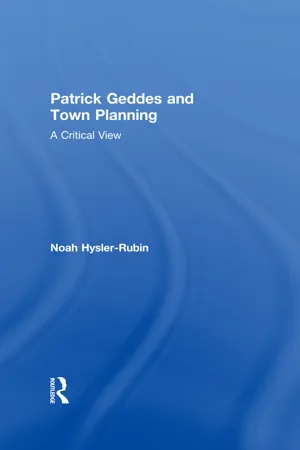Beginnings in Britain
Reviews described Geddes’ first official task of planning in Dunfermline as comprehensive beyond precedent, acknowledging the planning report’s imagination and enthusiasm and marveling at its specificity as a utopia.9 But, as Helen Meller claims, the popular press tended to misunderstand the work. Moreover, many of Geddes’ colleagues were baffled.10 T. C. Horsfall, “despite his record of being a campaigner for bringing Art and Beauty to the city,” refused to review it.11 Ebenezer Howard was highly appreciative, “though there may have been a barb,” says Meller, “in his comment that a copy of the report should be in every public library,” presumably thinking it was inspirational rather than practical.12 Charles Booth and Walter Crane highlighted the artistic value of Geddes’ suggestions and the importance of conservation raised in his “charming volume.”13 Another critic simply asked to see the extension of the projects to the population itself.14
Patrick Abercrombie described the first International Town Planning Conference held by RIBA in 1910 as Geddes’ first town planning emergence into public after having “long been subterraneously at work.”15 The Town Planning Review marked out Geddes’ unique contribution amongst many other participants.16 According to Philip Boardman, the London newspapers recognized that in Geddes’ gallery lay the keynote of the whole international exhibition: The Standard, for example, told its readers to head straight for the Edinburgh room if they would understand what town planning was all about.17
Yet Geddes’ approach was ambivalent and somewhat problematic. In a later account of the exhibition Abercrombie described how Geddes, in “that nightmare of complexity, the Edinburgh Room,” shattered the idea that town planning was a simple thing, composed of basic elements. In an often quoted passage Abercrombie accuses Geddes of torturing his crowds.18 Following the conference, Geddes had secured support from the leaders of the British town planning movement for his exhibition; but invitations from large cities were not forthcoming and it was only displayed in Edinburgh, in Dublin, and in Belfast.19
The exhibition in Dublin in 1912 was mainly an impetus to the competition of the planning of the city in 1914. The plan and later exhibition were followed closely by the Town Planning Review, mentioning the prize offered by Earl of Aberdeen, Lord Lieutenant of Ireland, and naming Geddes as one of the three adjudicators. Geddes’ great Housing and Town Planning Exhibition was described as part of the overall Civic Exhibition.20 The Irish experience, claims Meller, was crucial in establishing Geddes’ position in the British town planning movement not the least because of his association with Raymond Unwin and Patrick Abercrombie.21 When the exhibition was lost in sea, Defries wrote: “Many of us considered that this would be the end of Patrick Geddes. His name was so little known to the general public that it had never occurred to me that he had any real following… to whom did it matter that Geddes’ Exhibition of his ideas was destroyed?”22
Town planning in India and in Palestine, 1914–25
Geddes’ work in India received great local press coverage, reporting mainly about the town planning exhibitions and accompanying series of lectures and calling the public to take advantage of the great and unique occasion, as in “a carnival of fine speeches… Professor Geddes unravels the town-planning mysteries to an admiring audience.”23 “Geddes has come out to India to give us the benefit of his experience of towns and cities and men in Europe, America and Asia, and the huge collection of photographs and drawings …”24 In Britain, many articles in the new planning magazines were devoted to town planning in the colonies in general and in India in particular, describing work of local improvement trusts and municipal committees; none of these mentioned Patrick Geddes or his work.25
In Palestine Geddes’ work was celebrated by magazines for bringing modern ideas into the building of the old–new homeland.26 Unlike his work in India, though, it also drew attention in Britain, where Geddes was reported as working “to plan toward the development of Palestine as a land flowing once more with milk and honey,”27 introducing the newest innovations in town planning into Palestine while also preserving its unique traits.28 “They who hesitated to follow his suggestions for rebuilding Edinburgh, Dundee, or Aberdeen,” claimed Boardman, “heartily approved when it was a question of Jerusalem.”29 The Garden Cities and Town Planning Journal described the Jewish settlements in Palestine as an ideal return to an agricultural mode of life, a perception later strengthened by others.30 The Egyptian Gazette described Geddes’ vision of Haifa as a Town Beautiful.31 Flattering and enquiring letters came also from Charles Zueblin in America and Thomas Adams in Canada.32 The planning of the Hebrew University was closely followed and its opening ceremony described as an event arousing unusual interest, “not only among Jews but also among all civilised people’s.”33 Amelia Defries later wrote of Geddes’ work in Jerusalem, “do I exaggerate when I say that… it seems that Patrick Geddes is helping to lay the foundation of living faith – based upon the realities of science – and elastic for development and discovery?”34
